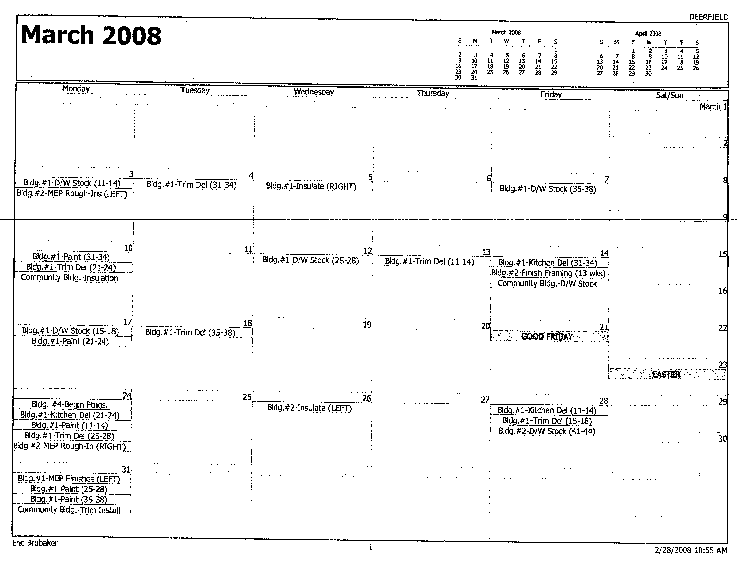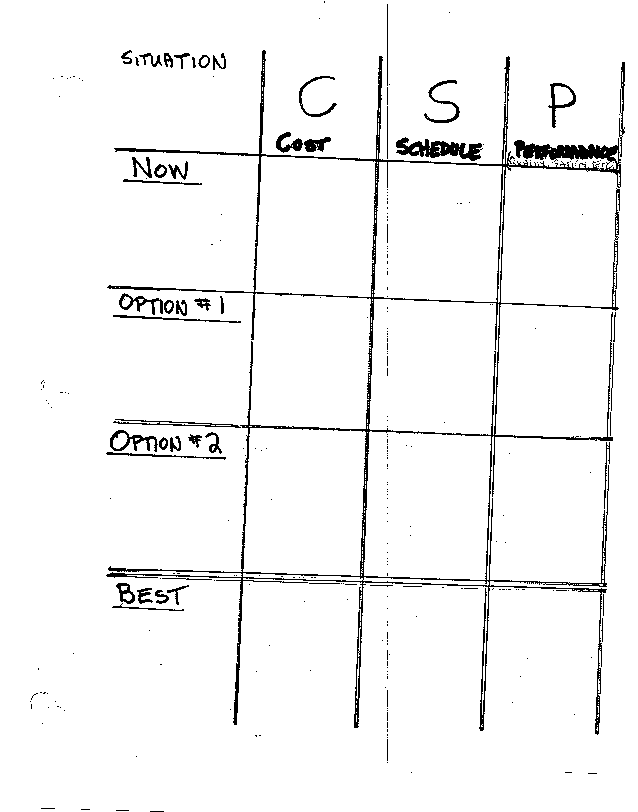 CONSTRUCTION KNOWLEDGE >>
JOBSITE MANAGEMENT >>
CONSTRUCTION KNOWLEDGE >>
JOBSITE MANAGEMENT >>
JOBSITE MANAGEMENT
1. Why is Planning and Scheduling Important?
2. How Do I Plan for the Week's Work?
3. What's Critical Path and Why Should I Focus on It?
4. What Should I Know about Costs?
5. How Do I Stage Materials and Activities on the Jobsite?
6. What Should I Know about Safety on the Jobsite?
7. What Should I Know about Quality Control on the Jobsite?
8. How Do I Make Better Decisions on the Project?
Why is Planning and Scheduling Important?
A construction project, whether large or small, needs a detailed, written schedule. In the construction business, when we get done always matters. But how we get done also matters. If we just ramrod our way through a project, pushing and threatening our way to completion, we probably leave a trail of inefficiency in our path. That inefficiency hurts the subcontractors and the material suppliers, the project Owner, your own firm and you.
You might say, "Hey, I got this difficult project done on a tight schedule, mostly by my own force of will. The Owner's glad we got done on time, how could this hurt me?" The simple answer: you have to start another project next week, then another one next year and on and on. If you consistently get done on time by abusing everyone around you, forcing them to be inefficient and lose money, those people and firms will eventually figure ways to protect themselves. Maybe they will refuse to bid on projects you run, maybe they will set revenge traps for you. But one way or another, you will develop a reputation as a Construction Supervisor to avoid. And that hurts you.
On the other hand, if you get done on time by working efficiently to a schedule, adapting as you need to when problems come, but communicating those changes well, you develop another type reputation. You become the Construction Supervisor that everyone wants to work with. Please note here, I'm not saying you can just be a nice guy and not get the project done on time (that won't work for anyone). I'm saying you get done on time by excellent planning, scheduling and communication.
So develop your own planning and scheduling tools to help you get the project done on time...with a minimal body count.
How Do I Plan for the Week's Work?
A simple written 3 week schedule helps many Construction Supervisors plan for the next week or two. Take the time to think deeply about what needs to get done in the upcoming few weeks. Then write it down! Get in the habit of committing your plans to writing and gain the following benefits:
- Your plan can be communicated more easily...just give people copies.
- As other involved parties really understand your plan, they will often improve it, helping you avoid embarrassing mistakes.
- Your plan can be more detailed, in types of tasks, locations or whatever.
- You eliminate the excuse that your expectation wasn't clear.
Many different formats can work for jobsite planning. You may like a simple grid in which you list the activity, location, who's doing the work and the next two or three weeks. I've attached a planning document we developed by inputting the schedule into Microsoft Outlook, then printing out monthly plans for all the onsite foreman.

Whatever the format you use, do a written plan to help you schedule the project. It's worth the time and effort.
What's Critical Path and Why Should I Focus on It?
Most larger construction projects will have an overall project schedule based on the Critical Path Method (CPM). While more fully described in the link above, the critical path method shows which activities can be delayed and not change the project end date (which are called non-critical activities). A CPM schedule also shows which activities move the completion date back with any delay (called critical path activities). Obviously, there's a great advantage in knowing these critical path activities and focusing on them.
Let's go through a simple example. The scheduled activities for a simple factory building are as follows:
- Sitework to get the building pad
- Concrete footings and foundation walls
- Structural steel frame
- Roofing and siding
- Under-slab mechanical and electrical rough-ins
- Concrete floor slab
- Interior walls and finishes
So anyone moderately familiar with construction could review that list and see that each of those activities follows the previous one. We certainly can't erect the steel if the footings aren't in place; we can't place the concrete floor previous to the under-slab rough-ins. So each activity would be critical path, right?
Well let's think a bit more deeply about roofing/siding and under-slab rough-ins. If we have good weather, we may be able to start on the under-slab rough-ins before, or at the same time, as the roofing and siding. Say the under-slab rough-in takes 5 days and the roofing and siding takes 15 days.
Maybe we could complete the under-slab rough-ins, place the concrete floor slab and even start on the interior walls before we get the roofing and siding completed. If we decide to proceed that way, the critical path runs through those first three listed activities, but the roofing and siding is not on the critical path. It could be started and completed a bit later and not hold up the overall project completion date. In CPM terminology, the roofing and siding has float.
So a Construction Supervisor should always know which activities are on the critical path. Those activities must be closely watched, pushed forward whenever possible and never allowed to slip backward without attention. Paying attention to critical path activities becomes second nature for any good Construction Supervisor.
How to handle the float activities, though, varies. The first concern that often arises is, "Who owns the float?" If we go back to our simple industrial building example above, the roofing and siding has a bit of float. Say that activity could start the same day the under-slab rough-in starts, or it could start 5 days later, and either way the project should finish on the same day. If the Roofing Contractor says, "I'm busy on another project, I know I said I'd start on this date, but it doesn't hurt the completion date if I move in a week later," then he is taking ownership of the float.
I generally think the Construction Supervisor should own the float, demanding other contractors work to an agreed upon schedule rather than allowing the float to get used for the convenience of others. To stay with the above example, say the Roofing Contractor uses the float and starts a week later, then has a material delivery problem and now drywall is ready to go on the walls but can't because it might get rained on. So you should always know the critical path and you should own the float.
What Should I Know about Costs?
Profit isn't a dirty word. Most people seem a bit ashamed of the concept of making a profit. Though rarely expressed, or even thought about it, for most people the concept of profit brings images of Ebenezer Scrooge...greedy, selfish, mean-spirited.
Whether you own your business or work for the owners, you need to understand why profit isn't just nice, it's essential. Profits allow the following:
- Create a cushion that helps a business survive if revenues dip or expenses spike.
- Provide capitol for re-investment into the business to allow for expansions, quality improvements, improved efficiencies, etc.
- Provide capitol to support charitable or local good works.
- Build wealth as a reward for the risk of running a business.
So if a company doesn't consistently make a reasonable profit, it's unlikely to survive. If the company folds, it doesn't meet warranty obligations, stops paying employees, often leaves vendors unpaid and no longer builds wealth for the good of the owner and the surrounding community. So please understand that profits are necessary.
The amount of information a Construction Supervisor has about job costs varies greatly between companies. Some firms share all that job cost information and some share almost none. If your company shares cost information, learn to understand what they provide. Take the time to understand what the estimate really means, be able to read through that estimate and understand every line. If you receive a monthly job cost report, take the time to study it. Know where the project stands financially and what you can do to influence the outcome.
Probably your biggest area of influence for job profitability will be labor productivity and handling change requests. Let's start by considering labor productivity. If there are 80 doors to set on the project and a two person carpentry crew was estimated to set eight doors per day, then 20 man-days are budgeted for that task. Prior to starting any task, both you and the working crew should know the estimated time for the task. So does your job end by telling the crew they've got 10 crew days to get the doors hung? Maybe. If that crew has the authority to:
- Have the right tools.
- Have the materials as needed for efficient installation.
- Deal with obstacles in their path.
If the crew doesn't have the authority to deal with these issues, then you need to. Many construction industry surveys have shown the largest de-motivators for construction trades-people are poor planning, not having the correct tools/materials to work efficiently, and poor communications. As the Construction Supervisor, you should have the capacity to help the trades-people work efficiently, which truly makes a win-win solution.
The typical construction project has a slew of requests for changes, continuing all the way from beginning to end. Your level of involvement in requests for changes will vary, but you need to know what your company expects of you. Too often unclear, or unrealistic, standards allow job cost disasters to occur. One amazing fact about the construction business is how often a construction company loses an incredible amount of money on a project. Changed conditions and requests for changes often lead to these huge losses. A good Construction Supervisor knows how to handle various types of change requests with various types of customers.
How Do I Stage Materials and Activities on the Jobsite?
The short answer...have a plan. Too often construction sites are just a huge happening, with lots going on but no one really directing the activities. That's the job of the Construction Supervisor, to direct activities on the jobsite.
I've found that a site plan, marked up with colored markers, easily shows a plan for a certain phase of the job. You probably want to have several blank site plans, so you can mark up plans for the various phases of the project. The staging needs to be different at the earthwork phase, then at the steel erection phase, than at the interior finishes phase, than at the punch list phase. So get a few copies of a site plan, some colored markers and stage your jobsite.
What Should I Know about Safety on the Jobsite?
Don't start with fear about an OSHA inspection. Start with a clear understanding that a good Construction Supervisor runs a safe jobsite. Understand that you need to set up the jobsite to operate safely and watch to make sure it does. The contracts are always full of language to try to make safety someone else's responsibility. We all understand, of course, that when a co-worker gets hurt and the lawsuits get rolling, every firm jumps for cover. That shouldn't be our focus, though.
We need to really look at how the jobsite will work, then how it is working. We need to understand how people get hurt and what things we can do to help avoid injuries. Let's begin by looking at the top 10 list of most frequently sited OSHA standards on a construction jobsite. It's important to get familiar with those standards and evaluate you jobsite. I believe the biggest change that needs to occur to improve construction safety (which is currently lousy) is the Construction Supervisors really seeing a safe jobsite as an integral part of his or her job.
Some additional construction site safety information is shown elsewhere on this site.
What Should I Know about Quality Control on the Jobsite?
Let's begin with a question; what is quality? Have you ever thought about what we're shooting for when we strive for quality? Perhaps you define quality as doing the job to as close to perfect as you possibly can. Some define quality as goodness, or excellence, or some other vague concept. If we're going to control quality on the jobsite, we're going to have to move the definition from some vague concept to something specific.
I notice construction quality when I travel to different parts of America and the world. I live in the Lancaster County, the Pennsylvania Dutch Country that has lots of craftsman from German backgrounds. We expect, and deliver, high quality in our area. The wood trim miter joints are almost perfect, the electrical conduit runs are straight, evenly spaced, a thing of beauty. We just have a history of high quality workmanship in our area. So if some shoddier workmanship occurs, it tends to get noticed and replaced.
A few years ago I toured a friend's jobsite in Atlanta, GA and was surprised by the lower level of quality. I learned, though, that what I saw was typical for that part of the country. The concrete joints weren't particularly straight, the caulking was a bit sloppy to my standards, the finishes just weren't what I was accustomed to. These were not defects most people would notice, and certainly not items that would affect the performance of the facility. These were just the acceptable standards for that area.
I helped build a couple of projects in Haiti and saw much different standards of quality. The construction industry there works mostly by eye, simply not having the measurement devices we have become accustomed to. So what is quality? By the observations I just made, you may conclude the better the quality, the better. You may conclude that perfection should be our quality goal. I think that's wrong.
We should define quality as meeting expectations. We should not be striving for some undefined concept of perfection. We should struggle before we start to understand what matters and then define that expectation, then meet it.
If you've been taught about quality improvement or quality assurance, the
concept of defining expectations clearly probably makes sense to you. If this is
a new concept for you, it will take some additional study.
![]()
How Do I Make Better Decisions on the Project?
I learned a great technique 25 years ago that I still use often. When the feces hits the fan on a project, when things are no longer proceeding according to plan, Construction Supervisors and Project Managers need to react. Since that situation occurs so often on construction projects, a technique that guides the decision making process really helps.
The simple, but effective technique is to think, "Cost, Schedule and Performance." When you are evaluating where you are and what options you may propose, always think in terms of cost, schedule and performance. Jot down some notes about the current situation, what will be the effect on the project cost, the project schedule and the project performance (quality, safety, acceptability, etc). Then think about a couple of possible scenarios, ways you might try to solve the problem. With each scenario, write down how it affects the cost, schedule and performance on the project.
The blank chart below can be printed for your use or you can just grab a piece of scrap paper and draw some lines. Remember, taking the time to think about C/S/P will almost always give you better solutions. If you become the person who consistently finds solutions to the problem, or even avoids the problem before it arrives, you become much more valuable. Project Owners and Design Professionals will want you on their projects. Learning leads to advancement.


